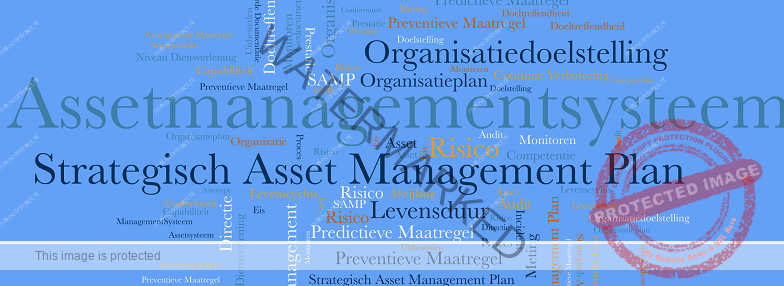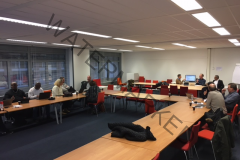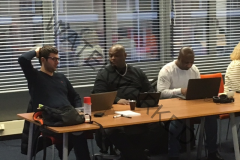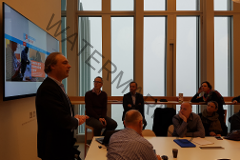![]()
![]()
The research explores the SAMP, what is a SAMP, what does it include and to what extent it providing a framework for the creation, implementation and finalization of maintenance concepts such as Main Contracts or Integrated Performance Contracts. The study has not restricted to only the variables that make up a SAMP exist but are all 39 (thirty-nine) Evaluating Variables See Invoice Asset Section 3.2.1 that include the use Asset Management to establish the SAMP. This has led to a SAMP three abstraction levels for the three organizational levels (Strategic, Tactical and Operational)
The chosen research approach to achieve a SAMP is the Delphi research method. Reason for this research are partly caused that (yet) standard procedure is to establish a SAMP and how it should look within the framework of the investigation. The outcome has led to insights into the framework of the maintenance concept Maincontracting but also how the policy can be linked to the smallest part of the asset that ultimately the framework is guaranteed as in Figure 1.
In the coming period wear this SAMP to the to establishment of a Maincontract with a participant. In this report a brief consideration in the establishment of a SAMP and the first insights.
The result: A SAMP on three levels
The result is a SAMP at three levels of abstraction. At the highest level, the SAMP abstract and concisely defined and is intended for the entire organization as a communication tool and a generic basis. For example, the tick the internal-and external context and the technical quality must be guaranteed alongside the primary process goes on happening in the Asset, typical characteristics of the asset and maintenance goals.
On the second level is the SAMP basically defined on the basis of the 39 (thirty-nine) variables. The variables are defined on the second level of abstraction and quantified. It is, however, indicates a broadening and deepening of the abstract document on the basis of the 39 (thirty-nine) variables where the organization is all about but also the context between the Asset Management System and the Asset Portfolio.
On the third level are the 39 (thirty-nine) variables completely defined and quantified the difference in goals. The latter is significant because a variable number of questions, each giving their own disparate goals insight into the outcome.
Limited Summary SAMP
The technical management and maintenance is contracted with the concept Maincontracting. This means that the contractor is responsible and competent in its activity to fill in ensuring the technical condition and the continuity of the primary process that takes place in the object. The frameworks and principles have been laid down in the Strategic Asset Management Plan (SAMP). On the basis of an investigation Delphi the SAMP is arranged. The Delphi worked with financial and policy leaders, operational managers and contract managers. Actually three groups representing the owner, performers and (internal) customers
The outcome of the research is summarized in nine subjects. These issues provide a high level of abstraction framework and starting point for the Maincontractor again. For example, the technical fitness level fixed for the life of the asset, are defined organizational objectives of the client, the structure of auditing and documented maintenance. What typifies the SAMP is that a number of activities during the investigation will determine the contract implementation phase.
During the authentication allows the contractor fixed on the basis of symptoms of faults which determine whether or not the contract price, and the MJOB be valid. In addition, the contractor fixed on the basis of standardized methods determine the critical and non-critical construction, installation -and its parts. preventive and corrective maintenance activities shall be determined on the basis of risk assessment and implemented. A feature of this approach is that the contractor have knowledge of the financial risks and can anticipate this by building, -and set out to make the contract. A result that can be adjusted transparently KPIs and SLAs.
Figure 2: The SAMP provides insight into the life of the asset is within the lifetime of an asset. (Click to enlarge)
The Research Approach: Delphi
The SAMP has been realized on the basis of the Delphi method. The aim of the Delphi study is the view and understanding of stakeholders and / or experts on the Asset Management to collect in a systematic manner and process. It is basically an interactive communication protocol between the researcher and the participants. Based on the Delphi Research created a joint opinion without interaction can influence the process and the outcomes. It is a structured form of group interview in qualitative research. By different officers each his / her own responsibility and authority questions and to submit subjects obtained understanding what the principles are and how the framework is formed.
In the first phase, individually or in groups to the participants, mostly experts, a question submitted with the request to respond. The researcher summarizes the responses together and draw conclusions from that. This report he lays back to participants for feedback, sometimes in a group discussion, sometimes individually. In the report, the investigator may possibly even send some depth questions. This process is repeated until a certain consensus has been reached, or a clear response was found at the research question.
- Formulate propositions and topics
- Theorems and topics to present to participants
- Opening of the group consulting problem
- Participants formulate first answer
- Researcher collects responses and summarizes
- Summary circulated
- Participants respond, complement and reconsider first answer.
The procedure
In the process model the same process steps are displayed and consists of seven process steps, namely:
- Research questions
- submit
- Analysis
- Conference call
- Process
- review
- final
Of each process step are some examples of the issues identified and their subjects.
- Press “previous” or “next” to go to the next process step or press directly on the step.
- In each process step, you will find tabs in which the subjects are grouped.
- the subjects are appointed by their questions and sub-questions per tab. Press tabs to view each tab
- Red colored words are provided with a definition; press the red words.
- Below procespannel is responsive and the most optimal view with a laptop or desktop.
Process Step 1 “Research Questions”
In an initial consultation with an official responsible for the Asset compiled the research. Primary goal is to give the research an understanding of the principles for drawing up the Maincontract.
Below are the research questions formulated in four separate tabs displayed.
-
- What should the technical condition of the asset throughout life
- There must be led by the client on site
- Who manages the documented information
- Are the organization’s objectives are incorporated in the contract
- Should the Asset Management Objectives are included in the maintenance contract
- The asset management plan is the responsibility of the client
- The Asset Management System is part of the maintenance contract
- Vervaningsbudget belongs to the contract
- Include facility management and / or technical activities belong to the contract
- What is the definition of a maintenance contract
- Substitutions in order to ensure the functionality and performance are among the contract price
- The contractor is responsible for the maintenance strategy
- The contractor is responsible for the maintenance management
- The contractor is responsible for the maintenance objectives
- The contractor is responsible for maintenance
- The contractor is responsible for auditing compliance with the BS 19011
- To what extent is the competence weighted by the client
- the extent to which the competence is weighed by the contractor
Figuur 3: Growth Asetmanagement & Maintenance (Click to expand)
Processchema (1)
Process Step 2 “Submit”
The formulated research questions are presented to the group officials. The aim is to enable the firm or the questions are valid and are a response to compile SAMP, what is contracted and what are the award criteria.
To determine this, and a research question an AHP analysis that the alternatives can be weighed should each research question the goals, alternatives and criteria to be determined. The following statement by the research question defined the objectives, alternatives and criteria.
Below are four separate tabs each main topic, the issues and questions listed with their goals and sub-goals. Press the “+” sign to open the subject.
In this example, two of the twenty-nine subjects have been appointed. Not all questions and alternatives are illustrated in this example. In this example, two of the five topics have been appointed. Not all questions and alternatives are illustrated in this example.
Processchema (2)

Processtap 3 “Analyse”
The substantive response will be analyzed by the researcher. The results are described and summarized.
This results in a framework in which the research play on the concept Maincontracting and a common response to the research.
Processchema (3)
Processtap 4 “Group Conversation”
In a group conversation the results wil be submitted. Based on the results there will be presented a written analayse. The group will react on the will their opinion based on arguments.
Processchema (4)

Processtap 5 “Process”
The research questions are answered in two ways. The reactions and results of the conference are described. the subjects are also “weighed” on the basis of AHP analysis. This creates beside the picture why one finds something of a particular subject an organization to the degree of importance.
The latter can be crucial when it comes to decision-making and prioritization. These issues are taken policy and have an impact within the framework that is defined within the Asset Management.
Processchema (5)
Processtap 6 “Review”
The results set out in stage 5 are submitted to the group whether the group can identify with what has been established. In particular, the focus will be on how to prioritize the issues on which the decision is based.
Processchema (6)
Processtap 7 “Final”
On the basis of the responses that have been given or agreement which may be identified by respondents were group. Based on the quakes conclusions can be drawn.
Processchema (7)
The results insightful
The results are currently being validated and published after completion. The preliminary findings and research results of this substudy to a SAMP are only available for limited number of participants.
- Click Here for the SAMP in article form (abstraction levels 1 and 2)
- Click here for the full SAMP covering all topics and components are visible and searchable (Login needed)
Pulse Publication Discuss or give your opinionFollow on FacebookFollow on Twitter













